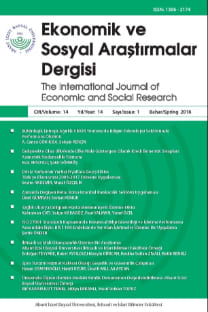TÜRKİYE'NİN SEÇİLMİŞ ORTADOĞU ÜLKELERİYLE TİCARETİNİN ANALİZİ
Türkiye, dış ticaretinin önemli bir kısmını Avrupa Birliği (AB) ülkeleriyleyapmasına rağmen, son dönemlerde özellikle global ekonomik krizle birliktediğer bölge ülkelerinin de önem kazandığı görülmektedir. Bu çalışma,Türkiyenin ortak kültürel ve tarihi bağları olan seçilmiş Ortadoğu ülkeleriyleticaretinin yapısını analiz etmektedir. Bu amaçla, 1999-2009 arasındaki dışticaret verileriyle ticaret yoğunluğu, Grubel-Llyod ve Balassa endekslerihesaplanarak sonuçların yorumları yapılmıştır. Yapılan hesaplamalar sonucundaTürkiyenin bu ülkelerle dış ticaretinin arttığı, bu ticarette endüstriiçi ticaretdüzeyinin genel olarak düşük, işlenmiş mallarda nispeten yüksek olduğu veTürkiyenin bir iki mal grubu dışında söz konusu ülke grubuna göre rekabetgücünün bulunduğu görülmüştür. Türkiyenin bu ülkelerle dış ticaretinin artmasıiçin, rekabet gücüne sahip olduğu sermaye yoğun malların ihracatına daha fazlaağırlık vermesi gerekmektedir.
ANALYSIS OF TURKEY S TRADE WITH SELECTED MIDDLE EAST COUNTRIES
Although Turkey has been trading with the European Union countries to a greatextent, especially after the global economic crisis, Turkey trade with the rest ofthe world has also gained importance. This study examines the structure of tradebetween Turkey and the selected Middle East countries which have commonhistorical and cultural bond with Turkey. In this context, intensity of tradeindex , Grubel-Llyod index , and Balassa index have been computed usingforeign trade statistics between 1999 and 2009, and the results have beeninterpreted. The results show that Turkey trade with those countries hasincreased, in this commerce network the intra-industry trade level is generallylow, on processed goods is relatively high, and Turkey has more competitivenesscomparing to those countries except for a few product class. In order to beprovided the trade enhancement between Turkey and those countries, Turkey needs to work on more export of capital-intensive commodities that turkey hasmore competitiveness on these.
___
- Akal, M. (2008), Ortadoğu Sınır Ülkeleriyle Dış Ticaret Yoğunlaşması ve Yapısal Değişim, Gaziantep Üniversitesi Sosyal Bilimler Dergisi, 7(2), 271-296
- Appleyard, D.R., Field A.J. ve Cobb, S.L. (2008), International Economics, Sixth Edition, New York, McGraw-Hill Irwin.
- Balassa, B. (1965), Trade Liberalization and Revealed Comparative Advantage, The Manchester School of Economic and Social Studies, 33(2), 99-123.
- Bano, S. (2002): Intra-Industry Trade and Trade Intensities: Evidence from New Zeland, Working Pap er in Economics, 5/02, University of Waikato, New Zealand.
- Bano, S. ve Li, S. (2005): The Evalution of Chinas Bilateral Trade Flows Over Time 1979-2001, International Trade and Finance Association 15th International Conf erence, Paper 2.
- Deviren, N. V. ve Karataş, M. (2007): Türkiye ile Çin Halk Cumhuriyeti Arasındaki Endüstri İçi Ticaret, İktisat İşletme ve Finans, 22(250), 16-32.
- Donges, J.B., Krieger-Boden, C., Langhammer, R.J., Schatz, K.W. ve Thoroe, C.S. (1982). The Second Enlargement of the European Community: Adjustment Requirements and Challenges for Policy Reform, Kieler Study , No.171, Kiel, Germany
- DTM (Dış Ticaret Müsteşarlığı), Dış Ticaret İstatistikleri, http://www.dtm.gov.tr/dtmadmin/upload/EAD/IstatistikDb/eko01.x ls,(25.09.2009)
- Erk, N. ve Tekgül, Y. (2001): Ekonomik Entegrasyon ve Endüstri-içi Ticaret: Türkiye-AB Ülkeleri Arasındaki Endüstri-içi Ticaretin Ölçülmesi ve Ticaret Tipinin Belirlenmesi, METU International Conf erence on Economics V, Ankara, September, 10-13.
- Erkan, B. (2012), Ülkelerin Karşılaştırmalı İhracat Performanslarının Açıklanmış Karşılaştırmalı Üstünlük Katsayılarıyla Belirlenmesi: Türkiye-Suriye Örneği, ZK Ü Sosyal Bilimler Dergisi, Cilt:8 Sayı:15, 195-218
- Erlat, G. ve Erlat, H. (2004), Türkiyenin Orta Doğu Ülkeleri İle Olan Ticareti, 1990-2002, GAP Bölgesinde Dış Ticaret ve Tarım içinde, Der: E. Uygur ve İrfan Civcir, Ankara: TEK Yayını, 33-56.
- Erlat, G. ve Erlat, H. (2005), Do Turkish Exports Have Comparative Advantage With Respect to The European Union Market, 1990- 2000, Proceedings of the Middle East Economic Association, 7, http://www.luc.edu/orgs/meea/volume7/erlat.pdf, 10.08.2012 Erlat, G. ve Erlat, H. (2003): Measuring Intra-Industry and Marginal Intra-Industry Trade: The Case for Turkey, Emerging Markets Finance and Trade, 39(6) November-December, 5-38.
- Grubel, H.G. ve Lloyd, P.J. (1975), Intra-industry Trade: The Theory and Measurement of International Trade in Diff erentiated Products, New York: John Wiley.
- Hinloopen, J. ve C. Van Marrewijk (2001), On the Empirical Distribution of the Balassa Index, Review of World Economics, Vol:137, No:1, 1-35
- Kaya, A.A., (2006), İmalat Sanayi İhracatında Uzmanlaşma: Türkiye- Avrupa Birliği Analizi (1991-2003), Ege University Working Pap ers in Economics 2006, No:06/05, İzmir.
- Kutlu, E. ve Yenilmez, F. (2005): Türkiye ile Avrupa Birliği Ülkeleri Arasındaki Endüstri İçi Ticaretin Önemi, İktisat İşletme ve Finans, 20(229), Nisan, 45-64.
- Ruben, E. (2003): Türkiye-İsrail Arasında Endüstri içi Ticaret Boyutunun İncelenmesi, İktisat İşletme ve Finans, 18(10), Eylül, 40-46.
- Serin, V. ve Civan, A., (2008), Revealed Comparative Advantage and Competitiveness: A Case Study for Turkey towards the EU, Journal of Economic and Social Research, Vol:10, No:2, 25-41
- Şimşek, N., Seymen, D. ve Utkulu, U. (2007), Turkeys Competitiveness in the EU Market: A Comparison of Different Trade Measures, Europ ean Trade Study Group (ETSG) 9th Annual Conf erence 2007, Atina.
- COMTRADE (2009), United Nations Commodity Trade Statistics Database, http://comtrade.un.org/db/mr/rfCommoditiesList.aspx?px=S3&cc= ,(30.09.2009).
- Utkulu, U. ve Seymen, D., (2004), Revealed Comparative Advantage and Competitiveness: Evidence for Turkey vis-a-vis the EU/15, Europ ean Trade Study Group 6th Annual Conf erence, ETSG 2004, Nottingham, 9-11 September.
- Yenilmez, F. ve Bayraç, H. N. (2005): Türkiye-Almanya Arasındaki Endüstri içi Ticaretin Gelişimi ve Endüstri İçi Ticareti Etkileyen Ülke Değişkenleri, E-akademi, 44.
- ISSN: 1306-2174
- Yayın Aralığı: Yılda 2 Sayı
- Başlangıç: 2005
- Yayıncı: Abant İzzet Baysal Üniversitesi İktisadi ve İdari Bilimler Fakültesi
